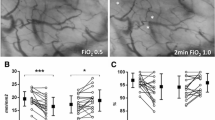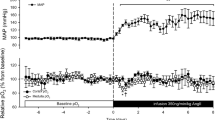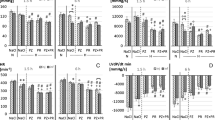Abstract
It has been hypothesized that autacoids, such as endothelin-1 (ET), may modulate erythropoietin (Epo) secretion. Therefore, we studied the effect of ET-1 infusion and of a nonselective ETA/B receptor antagonist on Epo secretion under carbon monoxide (CO) exposure. Anesthetized rats were supplied with room temperature air containing increasing concentrations of CO by an aerating cap. A CO–Epo dose–response curve over the range of 0.02–0.14 vol% CO was conducted. Subpressor doses of ET-1 (3 pmol/min/kg BW) and the ETA/B receptor antagonist LU302872 (LU; 30 mg/kg) were applied to anaesthetized rats under normoxia (controls CON, ET, LU) and following hypoxia (CO exposure; H-CON, H-ET, H-LU). Mean arterial blood pressure (MAP), glomerular filtration rate (GFR, inulin clearance), Epo and ET-1 serum concentrations (ELISA) and renal Epo mRNA (Light Cycler) were determined. The EC50 value for CO was 0.1 vol% with a 70-fold increase in Epo serum concentrations. CO exposure increased Epo serum and Epo mRNA concentrations in the expected range in all groups. None of the treatments with ET or LU influenced the effect of hypoxia on Epo serum concentrations and renal Epo mRNA content. Under hypoxia, administration of ET-1 as well as LU prevented the hypoxia-induced decrease in MAP (p<0.05). Under hypoxia, GFR was reduced by 50% except for H-LU with values comparable to normoxia. Taken together, the influence of hypoxia exceeds by far the effect of ET-1 on Epo production, irrespective of the presence or absence of exogenous ET-1. Thus, ET-1 does not appear to be a major modulator of Epo production.


Similar content being viewed by others
References
Amberg W, Hergenröder S, Hillen H, Jansen R, Kettschau G, Kling A, Klinge D, Raschak M, Riechers H, Unger L (1999) Discovery and synthesis of (S)-3-2-(3,4-dimethoxyphenyl)ethoxy-2-(4,6-dimethylpyrimidin-2-yloxy)-3,3-diphenylpropionic acid (LU 302872), a novel orally active mixed ETA/ETB receptor antagonist. J Med Chem 42:3026–3032
Barton M, Shaw S, d’Uscio LV, Moreau P, Lüscher TF (1998) Differential modulation of the renal and myocardial endothelin system by angiotensin II in vivo. Effects of chronic selective ETA receptor blockade. J Cardiovasc Pharmacol 31 [Suppl 1]:S265–S268
Benöhr P, Harsch S, Proksch B, Gleiter CH (2004) Does angiotensin II modulate erythropoietin production in HepG2 cells? Nephron Exp Nephrol 98:e124–e131
Brochu E, Lacasse S, Larivière R, Kingma I, Grose JH, Lebel M (1999) Differential effects of endothelin-1 antagonists on erythropoietin-induced hypertension in renal failure. J Am Soc Nephrol 10:1440–1446
Eckardt KU, Kurtz A, Bauer C (1989) Regulation of erythropoietin production is related to proximal tubular function. Am J Physiol 256:F942–F947
Elton TS, Oparil S, Taylor GR, Hicks PH, Yang RH, Jin H, Chen HF (1992) Normobaric hypoxia stimulates endothelin-1 gene expression in the rat. Am J Physiol 263:R1260–R1264
Freudenthaler S, Schreeb KH, Lucht I, Schenck T, Gleiter CH (2000) Dose-dependent effect of angiotensin II on human erythropoietin production. Pflugers Arch Eur J Physiol 439:838–844
Galat JA, Robinson AV, Rhodes RS (1988) The contribution of hypoxia to postischemic renal dysfunction. Surgery 104:257–265
Gleiter CH, Brause M, Delabar U, Zebski H, Eckardt KU (1997) Evidence against a major role of adenosine in oxygen-dependent regulation of erythropoietin in rats. Kidney Int 52:338–344
Goddard J, Johnston NR, Hand MF, Cumming AD, Rabelink TJ, Rankin AJ, Webb DJ (2004) Endothelin-A receptor antagonism reduces blood pressure and increases renal blood flow in hypertensive patients with chronic renal failure. Circulation 109:1186–1193
Goerre S, Wenk M, Bärtsch P, Lüscher TF, Nirooman F, Hohenhaus E, Oelz O, Reinhart W (1995) Endothelin-1 in pulmonary hypertension associated with high-altitude exposure. Circulation 90:359–364
Henry DH, Bowers P, Romano MT, Provenzano R (2004) Epoetin alfa. Clinical evolution of a pleiotropic cytokine. Arch Intern Med 164:262–276
Jilma B, Krejcy K, Dirnberger E, Eichler HG, Kapiotis S, Dorner GT, Wagner OF (1997) Effects of angiotensin II infusion at pressor and subpressor doses on endothelin-1 plasma levels in healthy men. Life Sci 60:1859–1866
Just A, Olson AJ, Arendshorst WJ (2004) Dual constrictor and dilator actions of ET B receptors in the rat renal microcirculation: interactions with ET A receptors. Am J Physiol Renal Physiol 286:F660–F668
Luippold G, Beilharz M, Muhlbauer B (2001) Reduction of glomerular hyperfiltration by dopamine D(2)-like receptor blockade in experimental diabetes mellitus. Nephrol Dial Transplant 16:1350–1356
Luippold G, Pech B, Schneider S, Osswald H, Mühlbauer B (2002) Age dependency of renal function in CD-1 mice. Am J Physiol Renal Physiol 282:F886–F890
Morganti A, Guissani M, Sala C, Gazzano G, Marana I, Pierini A, Savoia MT, Ghio F, Cogo A, Zanchetti A (1995) Effects of exposure to high altitude on plasma endothelin-1 levels in normal subjects. J Hypertens 13:859–865
Nir A, Clavell AL, Heublein D, Aarhus LL, Burnett JC Jr (1994) Acute hypoxia and endogenous renal endothelin. J Am Soc Nephrol 4:1920–1924
Östlund E, Lindholm H, Hemsen A, Fried G (2000) Fetal erythropoietin and endothelin-1: relation to hypoxia and intrauterine growth retardation. Acta Obstet Gynecol Scand 79:276–282
Perrella AM, Edell SE, Krowka, JM, Cortese AD, Burnett JC Jr (1992) Endothelium-derived factor in pulmonary and renal circulation during hypoxia. Am J Physiol 263:R45–R50
Pfaffl MW (2001) A new mathematical model for relative quantification in real-time RT-PCR. Nucleic Acids Res 29:e45
Ritthaler T, Göpfert T, Firth J, Ratcliffe PJ, Krämer BK, Kurtz A (1996) Influence of hypoxia on hepatic and renal endothelin gene expression. Pflugers Arch Eur J Physiol 431:587–593
Sigiura M, Inagami T, Kon V (1989) Endotoxin stimulates endothelin release in vivo and in vitro as determined by radioimmunoassay. Biochem Biophys Res Commun 161:1220
Sung CP, Arleth AJ, Storer BL, Ohlstein EH (1994) Angiotensin type I receptors mediate smooth muscle proliferation and endothelin biosynthesis in rat vascular smooth muscle. J Pharmacol Exp Ther 271:429–437
Syed N, Gulmi FA, Chou SY, Mooppan UM, Kim H (1998) Renal actions of endothelin-1 under endothelin receptor blockade by BE-18257B. J Urol 159:563–566
Takabatake T, Ise T, Ohta K, Kobayashi K (1992) Effects of endothelin on renal hemodynamics and tubuloglomerular feedback. Am J Physiol 263:F103–F108
Vemulapalli S, Chiu PJS, Griscti K, Brown A, Kurowski S, Sybertz EJ (1994) Phosphoramidon does not inhibit endogenous endothelin-1 release stimulated by hemorrhage, cytokines and hypoxia in rats. Eur J Pharmacol 257:95–102
Walker BR (1982) Diuretic response to acute hypoxia in the conscious dog. Am J Physiol 243:F440–F446
Wolf SC, Gaschler F, Brehm S, Klaussner M, Amann K, Risler T, Brehm BR (2000) Endothelin-receptor antagonists in uremic cardiomyopathy. J Cardiovasc Pharmacol 36 [Suppl 1]:S348–S350
Acknowledgements
This investigation was supported by the Federal Ministry of Education, Science, Research and Technology (BMBF, grant 01EC0001) and by funding of the Medical Faculty, University of Tübingen (fortüne, grant 952-0-0).The authors gratefully acknowledge the expert assistance of Mr. W. Beer.
Author information
Authors and Affiliations
Corresponding author
Rights and permissions
About this article
Cite this article
Grenz, A., Klein, J., Köhle, C. et al. Effect of endothelin-1 on erythropoietin production in a rat model under normoxia and functional carbon monoxide-induced hypoxia. Naunyn-Schmied Arch Pharmacol 373, 342–348 (2006). https://doi.org/10.1007/s00210-006-0085-y
Received:
Accepted:
Published:
Issue Date:
DOI: https://doi.org/10.1007/s00210-006-0085-y




